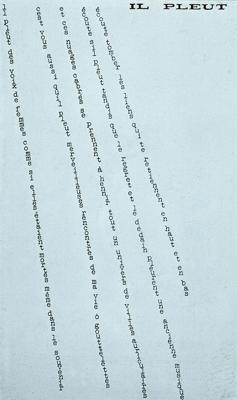E-Poetics
From digitalhumanities
[edit] History
We are currently living in the middle of a huge cultural revolution. The electronic technology we have available today has gone beyond mere communication, storage and information retrieval. This new media is changing the way we perceive language, ideas, the world and our selves. This shift in how we communicate has had an incredible affect on everyday life and also on the literature we read. Literature is an imaginative enterprise created entirely from words and deeply affected by this technology. Our comprehension of what this means to our society is still being evaluated. Average Americans now spend approximately twenty-four minutes a day reading. These precious minutes are divided between books, newspapers, magazines, diet tips, recipe cards and TV Guide. Books, magazines and newspapers are not disappearing, but their position in the culture has changed significantly over the past few decades, even among the educated. According to Dana Gioia, young intellectuals are not against reading but view it as one of the options for information. And, as the poet-critic Jack Foley said, "At the current moment writing is beginning to seem 'old-fashioned.'"
- Poems That Go Upon entering this site, you get an overview of what these authors view as digital poetry and some history. The last update appears to be in 2004.
!["Walking Poem"by [Dr.Hugo Heyrman]](images/2/2a/Walkingpoem.gif)
[edit] Current Web Presence
According to David Orr, the World Wide Web is a glorious collection of the best that has been thought and said. The Web is home to hundreds of sites that talk about, pick on, poke at and generally mull over books, writers and writing. It would be impossible to list the thousands of destinations available on the web but Orr has gone to great lengths to explore several note worthy links and a brief description of what is available at each site. The link Web Lit will take you to a sampling of what is available.
- Poetry Portal Web presence
- Poem Hunter Web presence
[edit] Critical Analysis of the Web Presence
What do we feel today as we face a revolution of thinking about the world? What do we face losing and what might we gain? Paul Jones uses Keats' poem "Lamia" as an example of how he feels about the changing face of poetry in the digital world. The scientists and philosophers in Keats Lamia were involved with discovery. The means had not yet been found to break to prism that held the rainbow. Only technology could poke holes in the layer with an application of knowledge (not knowledge or discovery itself). In tying Keats to the presence of digital technology Jones states "IT is here and we must face it as the scientist faced the Lamia as he revealed her nature as common and a part of daily life. We need not embrace all of it, but we must not ignore it."
Today e-poetry on the web is not a so easily defined subject. Where once it was easy to distinguish the difference between poetry and other forms of expression, now there exists a plethora of creative images, documents and ideas. The very nature of the internet has allowed poetry to meld fluidly with other forms of cyber-expression including hypertexts, internet art and media. One of the attractive features of poetry online is its interactivity. The reader is no longer just a reader. E-poets and artists have the ability to put control in their audience's hands and readers now give new life to once static work. The interactivity of the reader can range from simply clicking a "start" button or choosing a link, to adding their own text and editing other's work. An example by Loss Pequeno Glazier shows how a static image is animated by the reader (click on the (I) to get started). According to Brian Lennon, the increase in visual writing may be seen as a response to the technological acceleration that permits more and more complex forms of information - from simple text, to static images, to animated and then to user-interactive text image clusters to co-exist in one information-delivery system.
- Web Journals If you have been living out in the woods somewhere for the past ten years or so you wouldn't realize the VAST impact of electronic media. Just a small spattering of journals available at this link.
[edit] Research guide
[edit] Current Resources
- Web Presence Analysis A site from Cornell University Library on how to measure the validity of a website. Asks pertinent questions pertaining to information sources.
- American Verse Project Electronic archive of American Poetry
- Code, Cod, Ode: by Loss Pequeño Glazier As smoothly as "code" flows to "cod" and then to "ode", poetic language is always engaged in the play of its parts.
- Wikipedia Concise description of e-poetry
- Electronic Poetry Center Glazier himself!
- An E-Poet Particular example of an e-poem
- Survey of E-Poets Questions put to prominent E-Poets
- Visual Poetry Type in a sentence; view the results
[edit] References
- Dana Gioia, Disappearing Ink: Poetry at the End of Print Culture, Hudson Review, Spring 2003, Vol.56 Issue I, pg 21-49.
- David Orr, The Widening Web of Digital Lit, New York Times Book Review, Oct 3, 2004; National Newspapers (27) pg. 26.
- Paul Jones, In Search of the Poetry in Technology Educom Review, Jan/Feb 1998, Vol. 33, Issue 1
- Brian Lennon, Screening a Digital Visual Poetics Configurations, Winter 2000; Volume 8, Number 1


